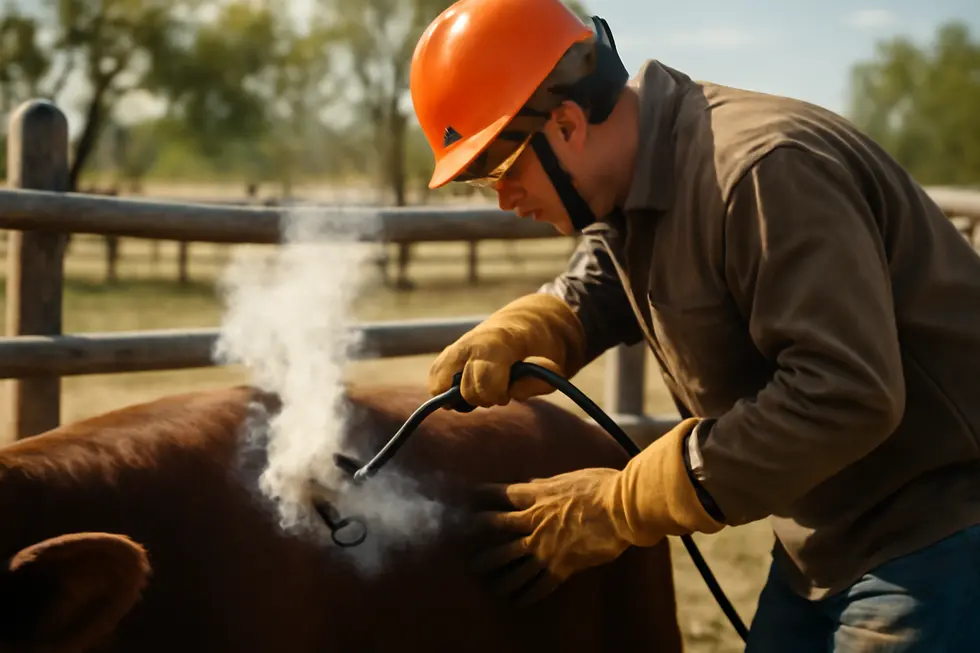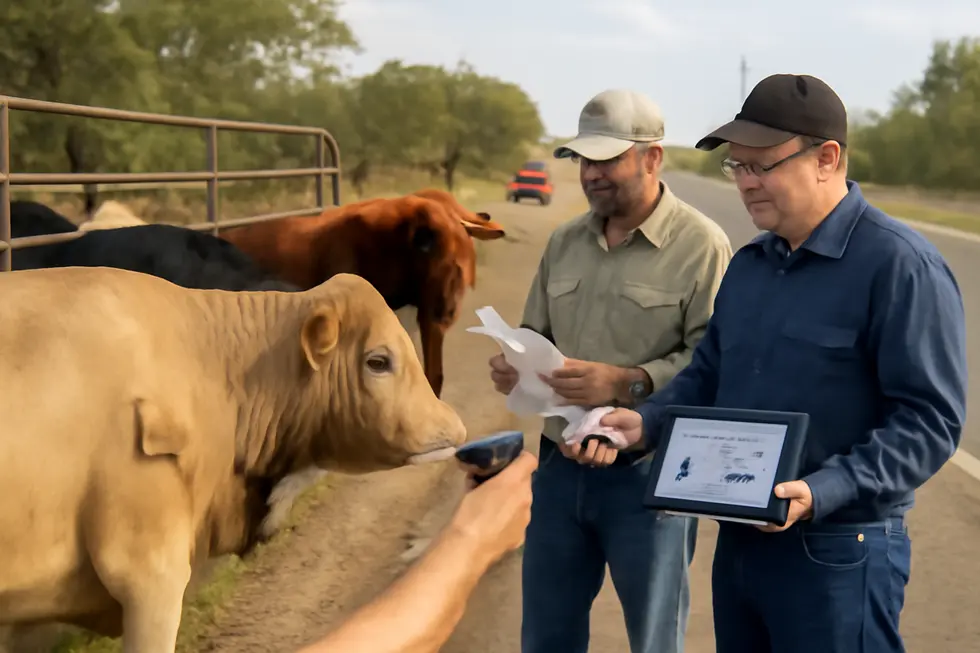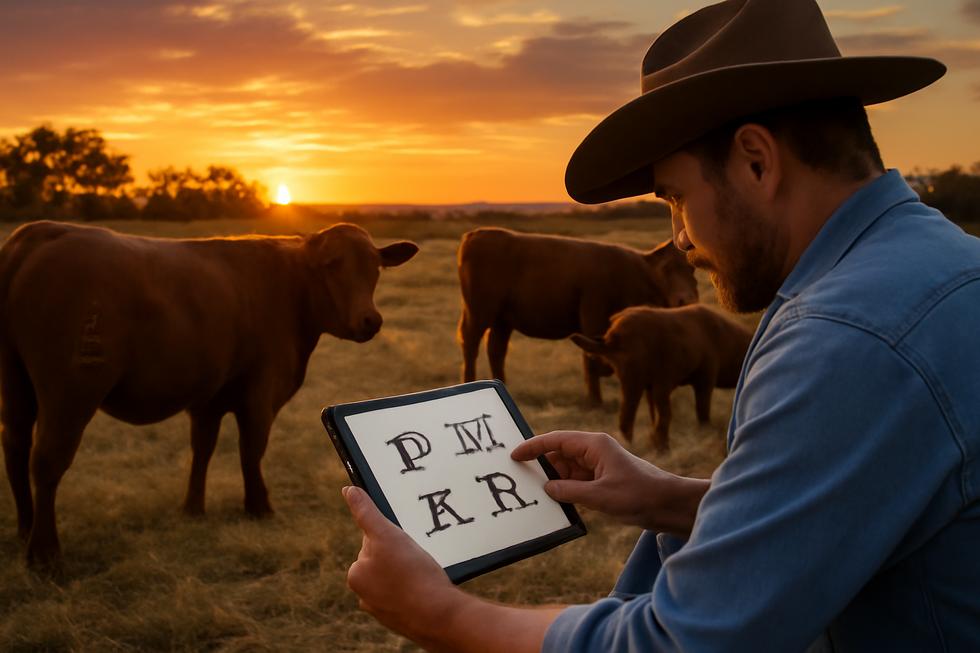Introduction
A livestock brand stands as a fundamental asset that establishes and secures ownership of your animals, providing undeniable proof while deterring theft. For business owners in livestock industries, understanding the multi-faceted process of creating and sustaining an effective brand is critical. From the initial design of a unique symbol through legal registration, proper application techniques, compliance with regulations, and leveraging digital tools, each step builds on the foundation of safeguarding your investment. This guide walks you through the integrated process, ensuring your brand not only stands out but is legally protected and efficiently managed for years to come.
Tables of Contents
Chapter 1: How to Make a Livestock Brand: Designing a Unique and Effective Brand
- Crafting a Distinctive Livestock Brand: Design Essentials and Legal Foundations
- Navigating Legal Registration and Practical Application for a Secure Livestock Brand
Chapter 2: How to Make a Livestock Brand: Legal Registration and Ownership Protection
- Crafting a Unique Livestock Brand and Securing Your Ownership Rights Through Registration
- Navigating State Laws: Ensuring Legal Ownership and Enforcement for Your Livestock Brand
Chapter 3: How to Make a Livestock Brand: Application Techniques and Best Practices
- Mastering Branding Methods: Practical Techniques for Clear and Humane Livestock Identification
- Mastering Ethical and Consistent Livestock Branding for Lasting Recognition
Chapter 4: How to Make a Livestock Brand: Complying with Legal and Regulatory Requirements
- Creating a Distinctive Livestock Brand and Navigating State Registration for Legal Protection
- Understanding Regional Brand Regulations: A Guide to Navigating Jurisdictional Differences and Usage Rules
Chapter 5: How to Make a Livestock Brand: Leveraging Digital Tools for Brand Design
- Building Legal Certainty and Physical Precision: Foundations for Digital-Enhanced Livestock Brand Creation
- Crafting a Distinctive Livestock Brand Identity Through Digital Design and Strategic Marketing
Chapter 1: How to Make a Livestock Brand: Designing a Unique and Effective Brand

1. Crafting a Distinctive Livestock Brand: Design Essentials and Legal Foundations
Creating a livestock brand that is both distinctive and legally sound requires thoughtful design paired with adherence to specific regulatory frameworks. The essence of a successful brand lies in its clarity and uniqueness—it must be easily identifiable at a distance and must not resemble any preexisting registered marks within the same jurisdiction. Typically, brands consist of simple shapes, letters, or numbers arranged in a pattern that symbolizes your herd or business identity. This clarity helps ensure rapid recognition during inspections or exchanges.
Legal compliance plays an equally crucial role; state and local authorities govern the creation and registration of brands to avoid duplication and disputes. You must submit your proposed design to the relevant department—often a state agriculture office or county clerk—with an application and the required fees. Once approved, your brand is officially recorded and protected, sometimes requiring periodic renewal, as practiced in states like Wisconsin. Certain marks, such as ear notches or disease control symbols, are excluded from branding and regulated separately.
When designing, simplicity enhances visibility and reproducibility. Complicated logos or symbols can be misread, diminishing their effectiveness. Consider the animal’s anatomy when selecting brand placement for maximum visibility and minimal harm. Traditional methods like hot iron branding remain popular, while alternatives such as freeze branding and tattooing offer different advantages and welfare considerations. Advances like microchip implants are emerging but are yet to replace physical branding widely.
Beyond practical concerns, your brand should reflect values or traits important to your operation, tying into long-standing breeding goals or herd characteristics. This alignment strengthens your brand’s meaning within the livestock community, fostering trust and clear identification.
Balancing traditional practices with legal and ethical standards ensures your brand not only marks your livestock effectively but also protects your ownership rights. For detailed guidance on navigating brand registration requirements and protecting your mark, explore resources focused on trademark protection for business names and logos.
2. Navigating Legal Registration and Practical Application for a Secure Livestock Brand
Creating a legally secure livestock brand demands more than just a distinctive design; it requires careful navigation through registration, maintenance, and application protocols to ensure your brand remains effective and protected. The first critical step is registering your unique brand with the appropriate state or county authority, such as the department of agriculture or county clerk’s office. This registration not only confirms your ownership but also establishes your brand’s precise placement on the animal, which must be consistent in all applications to aid identification during inspections and transactions. Ensuring your design is distinct prevents overlaps with existing brands and shields against future legal conflicts.
Ownership of the brand is not a one-time event; many jurisdictions mandate periodic renewals or rerecording to maintain rights. Missing these deadlines may lead to the abandonment of your brand, opening the door for others to claim it. Similarly, when ownership changes, whether by sale or assignment, formally recording the transfer keeps records clear and legally sound, avoiding disputes over rightful owners.
Practical application of your brand also carries legal weight. Brand inspections frequently accompany the sale, transport, or slaughter of livestock to verify identity and ownership, supporting traceability and preventing theft. Sellers should provide valid inspection certificates to ensure compliance with these regulations. Consistent branding on the designated body location simplifies these inspections and confirms authenticity.
If unauthorized use occurs, legal remedies such as injunctions and damages can be pursued, but proactive monitoring of the market is essential to detect infringements early. Beyond the physical brand, livestock enterprises benefit from registering intellectual property trademarks for business names, logos, and slogans, which offer broader protection and complement livestock brand registration. This layered approach strengthens your brand’s identity and legal standing.
By integrating thorough registration, renewal, precise application, inspection compliance, and vigilant enforcement — alongside potential trademark protections — you secure your livestock brand’s role as a lasting symbol of ownership and integrity. For a deeper understanding of how trademark protection can support your branding efforts, consider exploring resources on trademark protection for business names and logos.
Chapter 2: How to Make a Livestock Brand: Legal Registration and Ownership Protection

1. Crafting a Unique Livestock Brand and Securing Your Ownership Rights Through Registration
Creating and registering a livestock brand is a foundational step that not only distinguishes your animals but also firmly establishes your legal ownership. The process begins by designing a distinctive brand mark—a symbol or set of characters that is unique within your jurisdiction and easily recognizable. This uniqueness is crucial to prevent confusion or disputes with existing brands. Many regions, like Ohio, mandate that brands differ significantly to avoid misidentification. This design often combines letters, numbers, or symbols arranged in specific orientations suitable for clear branding on the animal’s hide.
Once your brand design is finalized, the next essential phase is official registration with the designated local or state authority. This requirement ensures your ownership is publicly recorded and protected. Typically, you must submit a detailed drawing of the brand, your personal or business ownership information, and specify the intended location on the animal where the brand will be applied. Different areas have varying regulations; for example, Queensland, Australia, processes registrations with a 40-working-day timeline, while Arizona insists on public advertisement before official recording and requires formal bills of sale for ownership transfers.
Adhering to regional rules concerning brand size and placement on livestock is critical. Some states insist on minimum size dimensions or require the brand to appear in particular locations on the animal’s body to standardize identification and enforcement efforts. Proper registration culminates in receiving a certificate that validates your rights, serving as a critical piece of evidence if ownership disputes arise.
Protecting your brand means maintaining thorough records of ownership and any transfers. Unauthorized use of your registered design is generally unlawful and may prompt legal action similar to trademark infringement cases. Vigilance and proactive enforcement can safeguard your assets and help preserve your reputation.
For those operating under a formal business entity, extra steps such as obtaining livestock dealer licenses and brand inspection certificates may apply, tying your branding activities into broader regulatory frameworks.
By meticulously crafting a unique design and securing its registration, you create a legally recognized symbol that safeguards your livestock investment. For more insights on how trademark principles apply to branding, you may find useful information in resources focusing on trademark protection for business names and logos.
2. Navigating State Laws: Ensuring Legal Ownership and Enforcement for Your Livestock Brand
Establishing a legally protected livestock brand starts with understanding and complying with state-specific regulations that govern brand registration, application, and enforcement. The process begins by crafting a unique design that is distinct from existing marks, reducing the risk of legal disputes and ensuring your brand can be securely registered. Each state maintains an official livestock brand registry — often managed by departments such as the state Department of Agriculture or local county offices — where your brand design must be submitted for approval. This step typically involves paying a registration fee, providing a detailed depiction of the brand, and securing an official certificate that confirms your exclusive rights to its use.
Once registered, your livestock brand becomes a legally enforceable marker of ownership. Unauthorized use or duplication of your brand can be challenged in court, giving you grounds to seek injunctive relief and damages against infringements. Many states also require owners to periodically renew or re-record their brands, a crucial duty that helps prevent brand abandonment and ensures ongoing protection of your rights. During livestock sales or transport, authorities may mandate official brand inspections. These inspections verify that animals carry properly registered brands, helping deter theft and misrepresentation. Sellers often must secure inspection certificates, proving compliance before animals change hands or cross state lines.
In addition to registration, state laws dictate humane standards for brand application methods and specify designated locations on the animal’s body for branding. Adhering to these regulations safeguards animal welfare while further reinforcing the legitimacy of your brand.
States like Ohio demand strict avoidance of confusingly similar marks and centralize registration with their Department of Agriculture, whereas Texas registers brands at the county level, maintaining electronic records tied to animal health authorities. Idaho enforces mandatory brand inspections with penalties for non-compliance, emphasizing the legal weight of proper branding practices.
For livestock owners engaged in commercial operations, integrating legal livestock brand registration with sound business structures such as LLCs can further protect your interests and clarify ownership rights.
By thoroughly navigating these state-specific requirements, your livestock brand not only serves as a unique identifier but also as a legally shielded asset, crucial for protecting your property rights and ensuring traceability across your animals’ lifespans.
For more detailed guidance on securing official rights to your livestock brand and understanding property protections, consult resources on cattle brand registration.
Chapter 3: How to Make a Livestock Brand: Application Techniques and Best Practices

1. Mastering Branding Methods: Practical Techniques for Clear and Humane Livestock Identification
Applying a livestock brand requires skillful techniques that balance clear identification with animal welfare. The two primary methods—hot iron branding and cold (freeze) branding—are longstanding practices, each with distinct advantages and considerations.
Hot iron branding uses a metal iron heated to a precise temperature and pressed firmly onto the animal’s skin. This process burns a permanent scar that distinctly marks ownership. Success depends on heating the iron until it is hot enough to create a crisp brand without causing deep tissue damage or excessive pain. The animal must be carefully restrained to prevent sudden movement, and the targeted branding area cleaned of dirt and hair. Applying steady, even pressure for the correct duration—usually a few seconds—ensures a clear and lasting impression, while minimizing injury.
Alternatively, cold branding relies on a branding iron chilled with liquid nitrogen or a dry ice-alcohol mixture. This method kills pigment cells in the hair follicles, causing hair in the branded area to regrow white rather than burning the skin. The result is a visible but less invasive mark that is generally considered more humane. Cold branding demands a precise application period to avoid incomplete or unclear marks. Proper restraint and site preparation remain essential, as does selecting animals with darker hides for best contrast.
Both techniques require a well-planned brand design that has been officially registered to prevent duplication or legal conflict. Preparedness and technique finesse reduce risks of infection, alleviate animal stress, and produce legible brands that stand the test of time. For producers seeking less intrusive options, combining branding with alternative identification methods such as ear tags or tattoos can enhance traceability while reducing animal discomfort.
Emerging technologies like AI-driven muzzle recognition are transforming livestock ID by offering accurate, non-invasive alternatives. Still, traditional branding remains vital for legal protection and market assurance.
Thorough record-keeping aligned with proper brand application improves livestock management and ownership clarity. For more on protecting your intellectual property in branding, see insights on trademark protection.
2. Mastering Ethical and Consistent Livestock Branding for Lasting Recognition
Creating an effective livestock brand extends beyond designing a unique symbol; it demands careful attention to application techniques that balance permanence, clarity, and animal welfare. To achieve a brand that remains easily recognizable throughout the animal’s life, it is essential to approach the application process with precision and consistency.
First, selecting the right tools and techniques is vital. Whether using hot iron, freeze, or acid branding, the method must be suited to the animal, local regulations, and your capacity to apply it humanely. For hot brands, maintaining the correct temperature avoids excessive damage while ensuring a clear impression. Freeze branding relies on cooling the brand to a level that kills pigment cells without causing undue pain. Each method requires skillful timing and steady application to form a distinct, legible mark.
Consistency in placement solidifies the brand’s role as an identifier. Applying the mark in the same location on every animal aids in swift recognition by inspectors, buyers, or other ranchers. This uniformity simplifies record-keeping and reduces the risk of confusion or misidentification. Moreover, aligning branding practices with state requirements—such as branding before a specific age or on designated body parts—ensures legal compliance and avoids future disputes.
Ethical considerations are paramount. Adopting humane branding practices minimizes animal distress. Proper handling, using sedation if necessary, and limiting branding duration contribute to better animal welfare. Responsible branding not only protects the livestock but also supports public perception of your operation.
Beyond the physical brand, integrating your livestock brand into broader marketing efforts strengthens your farm’s identity. Consistent use of the brand symbol in digital content, packaging, and social media campaigns builds familiarity and trust among customers. Sharing behind-the-scenes content or educational material about your branding practices can reinforce your reputation as a thoughtful, ethical livestock owner.
For those seeking deeper insights into practical techniques, watching detailed video demonstrations can be invaluable. Such resources provide visual guidance that complements written instruction, refining your ability to apply brands effectively.
In essence, mastering livestock branding involves harmonizing clear, consistent mark application with ethical care and broader branding strategies. This approach guarantees your brand is not only legally protected but also a respected emblem of your farm’s legacy. For more guidance on protecting your brand identity legally, consider exploring trademark protection for business names and logos.
Chapter 4: How to Make a Livestock Brand: Complying with Legal and Regulatory Requirements

1. Creating a Distinctive Livestock Brand and Navigating State Registration for Legal Protection
Designing and registering a livestock brand demand careful attention to both creativity and compliance. Your brand must stand out clearly, avoiding any resemblance to others already recorded within your state to prevent legal disputes and confusion. Typically, a livestock brand consists of letters, numbers, or symbols arranged in a unique configuration, abiding by size and style rules set by local authorities—for instance, Ohio mandates cattle brands be no less than three inches tall, with other livestock brands at a minimum of two inches.
Before registering, you must verify the availability of your chosen design through a state-maintained brand registry. This step ensures your mark is original and not deceptively similar to existing brands, significantly reducing the risk of rejection and future ownership conflicts. Once confirmed, submit the design to the designated state agency, which could be the Department of Agriculture or a county clerk’s office, depending on your jurisdiction. For example, Texas requires brands to be recorded at the county level where the livestock reside.
Upon approval, you receive official documentation that certifies your ownership, providing a legal foundation critical for protecting your investment and rights. It is essential to apply your brand only after this registration, as premature use can lead to fines or penalties. Moreover, many states enforce routine brand inspections, especially when animals change hands or cross state lines, reinforcing accountability and traceability within the livestock industry.
Beyond the brand itself, if you are operating as a commercial livestock business, ensure you also meet additional regulatory requirements such as registering your business entity and obtaining necessary permits or dealer licenses. These steps support lawful operation and brand legitimacy.
By integrating a unique, compliant brand design with official registration, you establish a robust legal identity for your livestock. This process not only safeguards your ownership rights but also aligns with important animal identification regulations, helping to prevent theft and facilitate disease control. For further insight into protecting names and marks beyond branding, exploring detailed trademark protection guidelines can offer valuable knowledge to strengthen your intellectual property safeguarding.
2. Understanding Regional Brand Regulations: A Guide to Navigating Jurisdictional Differences and Usage Rules
Creating a legally compliant livestock brand requires more than just a unique design—it also demands a thorough understanding of the specific rules and regulations that vary widely between regions. Different jurisdictions impose distinct requirements on how brands are registered, applied, and monitored to protect livestock owners’ rights and prevent fraud. This complex patchwork of laws means that producers must carefully navigate their local and regional regulations to ensure their brand is valid and enforceable.
In many areas, brand registration is handled by agricultural departments, livestock boards, or similar authorities, who maintain official registries to avoid duplication and confusion. The process typically involves submitting a detailed application that includes a clear brand design and proof of ownership. Some jurisdictions specify minimum brand sizes, allowable shapes, and exact placement on the animal’s body to maintain consistency and aid in easy identification. Furthermore, the selection of branding methods must align with welfare standards mandated by law—whether hot iron, freeze branding, or acid branding.
Jurisdictions also vary in their approach to enforcement and verification. For example, states like Ohio require brands to be recorded with the Department of Agriculture and hold brand sizes to minimum dimensions, while other regions like Namibia conduct regular brand verification campaigns to deactivate unverified marks. Queensland, Australia, mandates branding cattle before sale with specified size and location rules. Such rules extend beyond mere registration; they encompass how brands are used, transferred, and renewed.
Non-compliance can lead to serious consequences including invalidated ownership claims, fines, and restrictions on livestock sales. To avoid these pitfalls, producers must stay informed on current legal requirements, maintain meticulous records, and routinely verify that their brand remains registered and active. Consistent communication with regulatory bodies is essential to adapt to evolving regulations.
Mastering the nuances of livestock branding regulations not only secures legal ownership but also strengthens traceability in the agricultural supply chain. This compliance creates trust in livestock markets and protects producers from costly disputes. For more insight on protecting brand rights beyond livestock, exploring resources on trademark protection can offer valuable parallels in maintaining distinct marks and ownership.
Chapter 5: How to Make a Livestock Brand: Leveraging Digital Tools for Brand Design

1. Building Legal Certainty and Physical Precision: Foundations for Digital-Enhanced Livestock Brand Creation
Creating a livestock brand that stands the test of legal scrutiny and practical use requires a careful balance between regulatory compliance, physical execution, and modern technology. At the heart of this process lies the legal foundation: registering a unique brand design with the applicable authorities ensures exclusive ownership and protects against confusing similarities or duplications. Most jurisdictions—whether it be Ohio in the United States, Queensland in Australia, or Namibia in Africa—mandate registration of livestock brands with designated state or regional agricultural agencies. These registrations include strict rules for design uniqueness, size, and location of branding on animals to prevent forgery and assure clear identification. For example, Ohio requires cattle brands to meet a minimum size standard, typically three inches, for easy legibility and official recognition. Equally, jurisdictions like Queensland impose mandatory branding and registration deadlines before sale, utilizing streamlined digital submissions and online payments to facilitate compliance.
Physically, the brand’s application demands precision. The registered location on the animal’s hide—often the shoulder or hip—must be consistent with legal documentation to avoid disputes and ensure traceability. The brand’s size and clarity are critical so it remains identifiable throughout the animal’s life. Different methods such as hot iron branding or freeze branding are applied carefully to uphold animal welfare standards while delivering a permanent mark. This intersection of legal mandates and physical application is where digital tools contribute significantly. Using digital design software, livestock owners can create visually accurate and compliant brand marks that are easy to review and adjust prior to submission. These tools help preempt conflicts by ensuring designs are sufficiently distinct and meet jurisdictional guidelines.
Moreover, the rise of integrated digital registries and verification platforms, like those implemented in Namibia’s recent brand validation campaign, allows livestock producers to submit, track, and renew brand registrations efficiently. Such systems reduce processing times, eliminate paperwork errors, and enhance record integrity. Incorporating these digital innovations alongside the tried-and-true physical branding methods creates a more transparent, enforceable, and humane livestock identification system. Understanding and aligning these legal and physical foundations while leveraging digital advancements is essential to mastering the art of livestock brand creation.
For further insights into protecting and registering unique identifiers related to business and branding, exploring resources on trademark protection can offer complementary guidance applicable to livestock brand registration.
2. Crafting a Distinctive Livestock Brand Identity Through Digital Design and Strategic Marketing
Creating a livestock brand today extends beyond the physical mark applied to animals; it encompasses building a digital identity that strengthens recognition, trust, and market presence. Utilizing digital design tools allows livestock owners to create precise, scalable representations of their brands. This digital standardization ensures clarity, consistency, and ease of use across online platforms and printed materials, forming the foundation for a cohesive brand image.
Strategic digital marketing complements this foundation by amplifying brand visibility and engagement. Social media platforms such as Facebook, Instagram, and YouTube serve as vital stages for sharing the story behind the brand, showcasing livestock health and quality, and directly connecting with a community of buyers and fellow farmers. Rich content—photos, videos, and narratives—humanizes the brand and fosters loyalty.
Moreover, local search engine optimization (SEO) enhances discoverability for customers seeking livestock within specific regions. Registering the farm on directories and optimizing web content with regionally relevant keywords ensures that potential clients can locate and trust the brand with ease. Video marketing further deepens these connections, providing immersive glimpses into farm operations and animal care that build emotional resonance.
Maintaining visual and tonal consistency across all digital touchpoints—websites, social media, and e-commerce interfaces—reinforces brand identity and professionalism. Consistency in logo use, color schemes, and messaging style creates a seamless experience that customers recognize and appreciate.
Integrating e-commerce capabilities directly supports sales growth by simplifying product ordering and offering transparent pricing. Analytics and AI-driven insights enable brand owners to understand audience behavior and refine marketing strategies accordingly, increasing effectiveness over time.
Finally, advanced technologies like digital tracking and less invasive branding methods not only improve livestock management but also add a layer of authenticity and modern appeal to the brand. This entire digital approach enriches traditional livestock branding, transforming it into a multifaceted identity that thrives in today’s connected marketplace.
For additional insights on protecting your brand identity, consider exploring detailed guidance on trademark protection for business names and logos.
Final thoughts
Crafting a livestock brand goes well beyond just a symbol—it represents your legal ownership, brand identity, and commitment to ethical practices. By carefully designing a unique brand, securing legal registration, applying it through humane and effective techniques, and ensuring ongoing compliance with regulatory standards, business owners lay a robust foundation for protecting their livestock assets. The added power of digital tools enhances brand clarity and management, making the entire process more precise and future-ready. Successful livestock branding integrates creativity, law, animal welfare, and technology, empowering you to operate confidently and protect your investment effectively.
Your IP is the foundation of your success – let’s protect it together before it’s too late. We can’t wait to help you turn your ideas into legally secured assets.
About us
undefined


